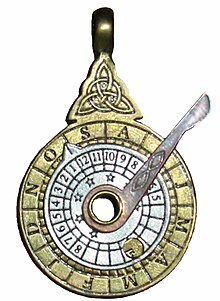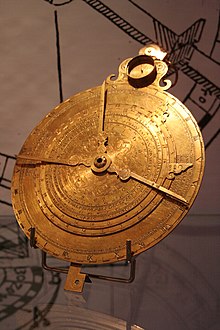Star clock
A star clock , also nocturnal or nocturlabium , is a medieval device for determining the night hours based on the position of the stars.
A star clock used in the northern hemisphere usually uses a star of the Great Bear , the star Kochab of the Little Bear, or the star Schedir of Cassiopeia as a reference point.
The earliest known description of the star clock comes from Ramon Llull in 1295. A detailed description can be found in the instrument book by Peter Apian . Another mention of the Nocturlabium was made by Martín Cortés de Albacar in 1551 in his work Arte de Navegar .
functionality
The instrument has two rotating discs, one on top of the other, with a pointer and a hole in the middle. The current date is set on one disk with the months of the year. The polar star is sighted through the hole and the pointer is placed on the polar guide (the stars α and β) of the Big Dipper . The time can then be read on the second disc. In Der Horologies, or Sundials by Sebastian Münster from 1553, there is a contemporary instruction manual that fits the historical depiction of the star clock by Peter Apian shown here:
“If you now want to know the hour of the night at night, you should pretend. During the day, turn the movable cog until the tooth with the number twelve falls on your day in the calendar or on the degree of sunshine in it, which is at the same time. So the instrument stands for the same day and is directed as it should be. Now when you wake up in the night and desire to know from heaven the hour before or after midnight, take the nocturnal in your hand with its handle and raise it in front of your eyes against the North Star and be careful that it does not hang to one side, namely to the left or to the right hand and look through the hole to the pole star, also see the two stars behind, that you can see the three stars together. One through the hole and the other two outside next to the perimeter of this instrument and when you have seen them all three, keep the nocturnal still until you move the rule over the pointer to the two stars behind. Then start counting from the tooth of the twelfth hour, behind you or in front of you, what you have for the next rule, so you will find the night hour. If you count two teeth from the big tooth of the twelfth hour and that to the left hand, it will be two hours after midnight. If you count a tooth on the right hand from the large tooth, it will be around the eleventh hour before midnight. "
literature
- Christian Leitz: Ancient Egyptian star clocks , in: Ernst Seidl (ed.): The sky. Ideal image and understanding of the world . MUT, Tübingen 2011, ISBN 978-3-9812736-2-5 , pp. 161-170.
- Wolfgang Schroeder: Practical astronomy for star lovers (including instructions for building a nocturnal). 1st edition, Kosmos-Verlagsgesellschaft, Stuttgart 1958.
Web links
- Nocturnal , Museo Galileo - Institute and Museum of the History of Science , Florence. Video on how it works and other illustrations
- Nocturnal , British Museum (English)
Individual evidence
- ↑ See Ernst von Bassermann-Jordan, Hans von Bertele: Uhren . Klinkhardt & Biermann, Braunschweig 1969
- ^ Harriet Wynter, Anthony Turner: Scientific Instruments , Studio Vista, 1975, ISBN 0-289-70403-0
- ↑ Ralf Kern: Scientific instruments in their time . Volume 1: From astrolabe to mathematical cutlery . Cologne: Walther König, 2010, p. 310.


